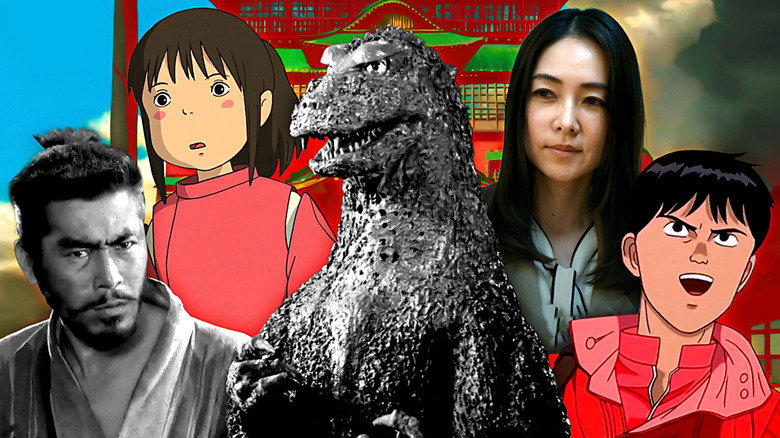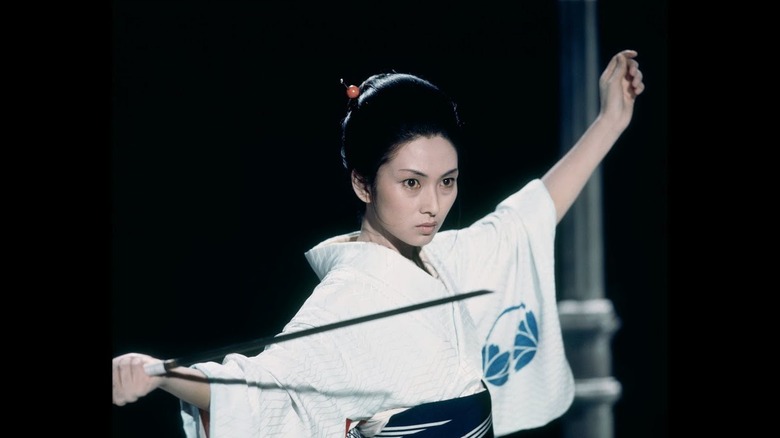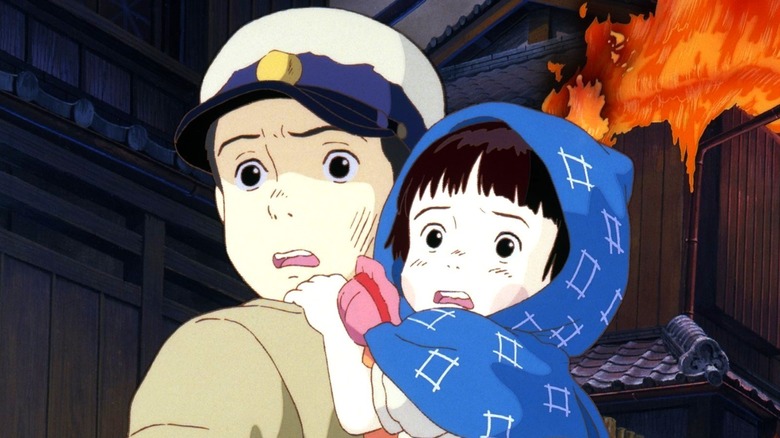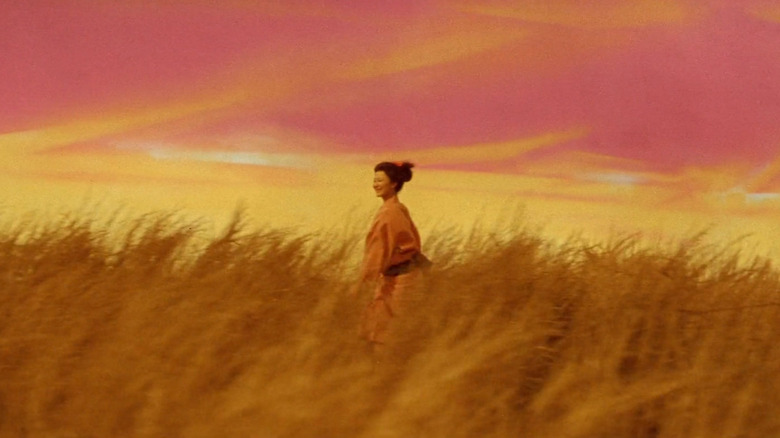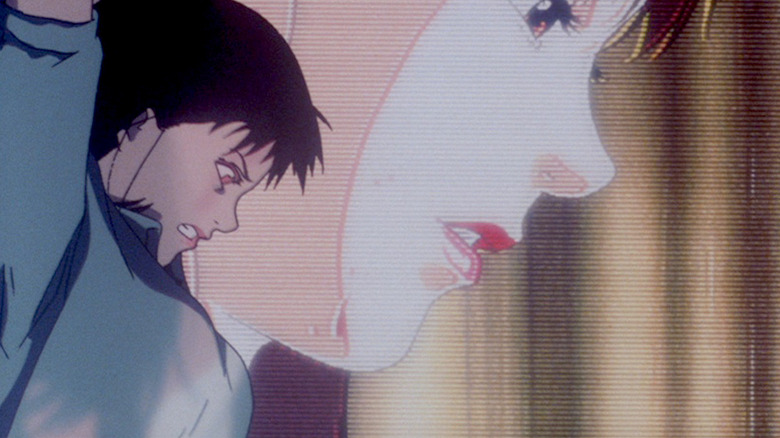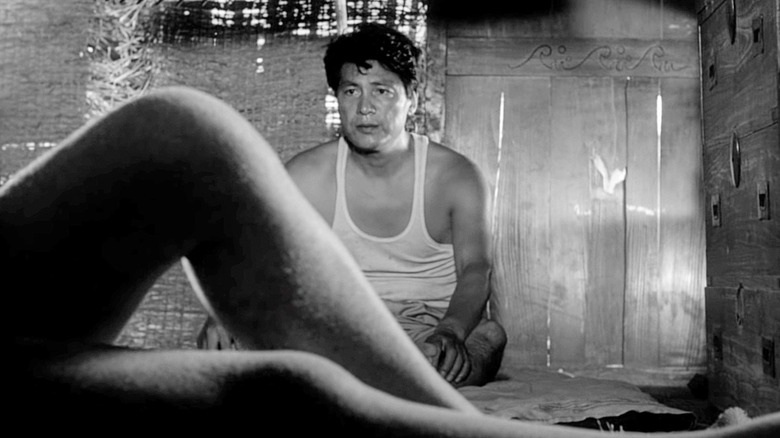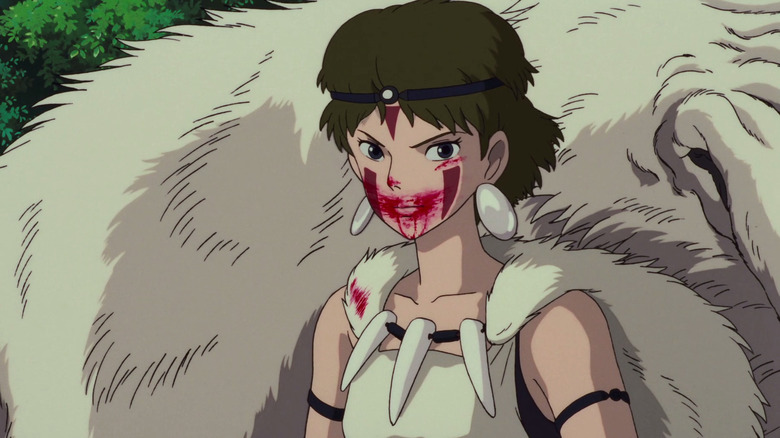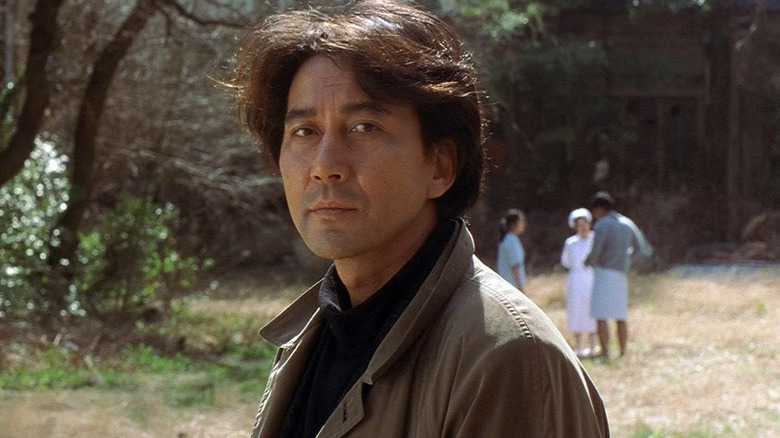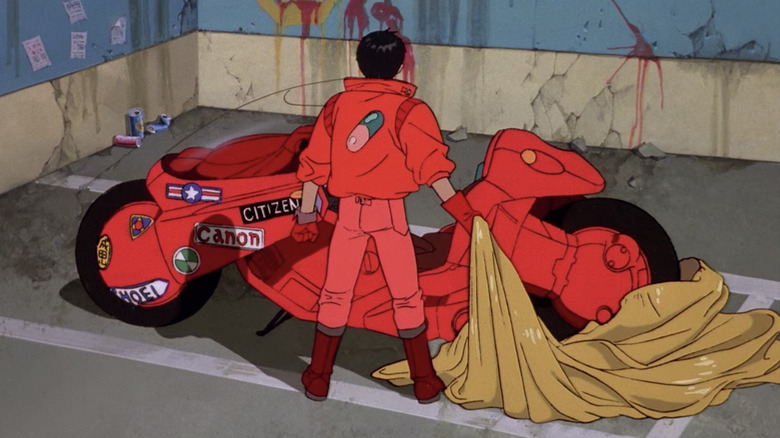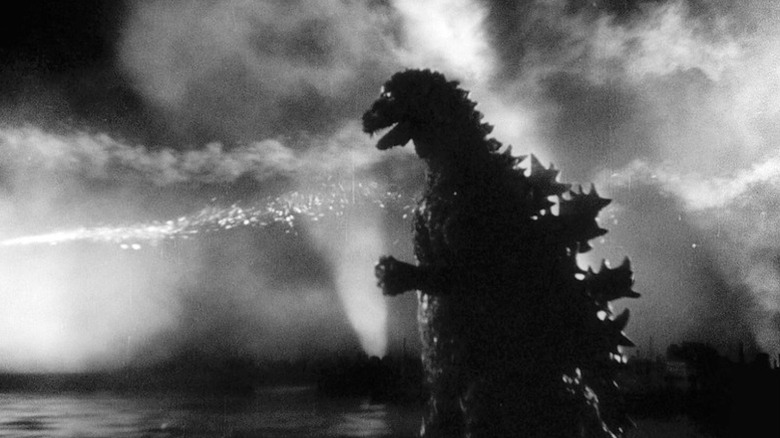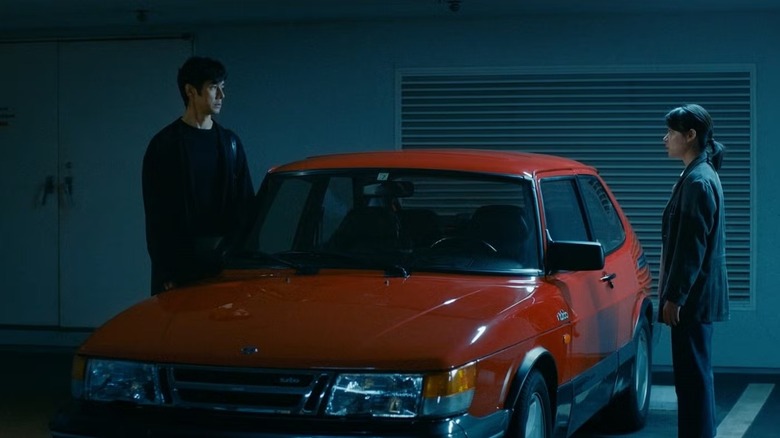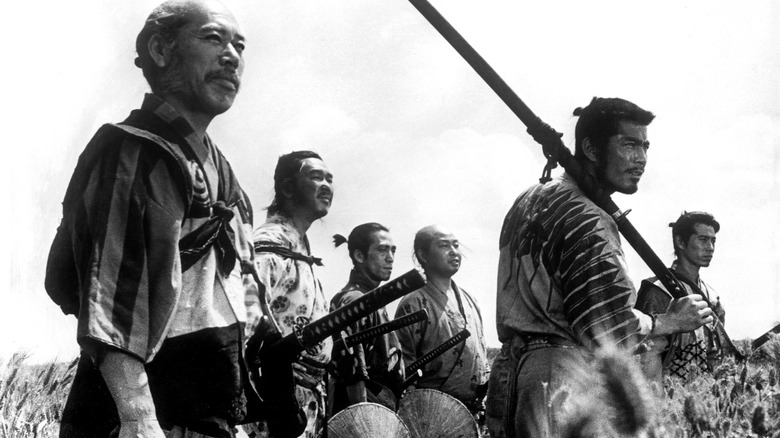The 15 Best Japanese Movies Of All Time Ranked
Japan has a long-standing reputation for expertly crafted cinema dating back to the silent movie era, with the Japanese movie industry rebounding in a big way following World War II. Whether it's sharply honed samurai movies or absolutely gruesome horror flicks, Japan has produced countless films acclaimed worldwide for decades. This distinction carries over to the country's animation industry, with anime renowned as some of the most popular and widely lauded animated projects in the history of the medium. Simply put, Japan has consistently earned international recognition for its artistic output, with its cinematic productions, in particular, receiving well-deserved accolades.
Japanese filmmakers, be it visionaries like Akira Kurosawa or prolific animation studios like Madhouse, continue to leave an impact on global cinema. With their influence visible in some of the biggest Hollywood movies and franchises, Japanese movies lead the country's culture being embraced abroad. Here are the 15 best Japanese movies of all time ranked and ready for curious viewers to check out next.
15. Lady Snowblood
East Asian cinema and television has a robust library of revenge thrillers, both set in the contemporary present and in evocative period pieces. One of the best and most influential to come from Japan is 1973's "Lady Snowblood," adapting the manga by Kazuo Koike and Kazuo Kamimura. The movie follows Yuki Kashima (Meiko Kaji) who swears to avenge her mother by killing the three men who ruined her life. Trained as a lethal assassin from a young age, Yuki tracks down these three figures with single-minded determination.
A clear inspiration behind Quentin Tarantino's "Kill Bill," right down to its climactic showdown in the snow, "Lady Snowblood" is a stylishly executed action flick. Meiko Kaji brings an unflinching edge to her performance as Yuki, with a real fire in her eyes as Yuki pursues her targets. The fights themselves are impressively staged, with the cinematography and set design really delivering on the atmosphere. A period piece revenge movie with a razor-sharp focus, "Lady Snowblood" helped define the action genre in Japan for years.
14. Grave of the Fireflies (1988)
The most emotionally devastating movie on this list, the 1988 anime movie "Grave of the Fireflies" is the kind of film you only need to see once. Set in the city of Kobe in the final months of World War II, the movie centers on children Seita and Setsuko after their mother is killed in a bombing. Fending for themselves, the siblings find it hard to acquire food as the devastated city's population starves. However, as much as Seita tries to care for himself and his younger sister, the full weight of this national tragedy ultimately proves too much for the kids to overcome.
"Grave of the Fireflies" is a perfect war movie, albeit one that focuses on the cost of conflict on innocent civilians rather than the soldiers perpetuating it. That this traumatic ordeal unfolds from the perspective of children makes the story all the more heartbreaking. No other anime movie packs the same emotional wallop as Isao Takahata's haunting anti-war masterpiece. An absolutely perfect anime movie, "Grave of the Fireflies" is the type of film that leaves its audience forever changed after a viewing.
13. Ran
The last historical epic helmed by legendary Japanese filmmaker Akira Kurosawa, 1985's "Ran" is a transposed adaptation of William Shakespeare's "King Lear" to feudal Japan. The movie revolves around a power struggle between the three sons of elderly warlord Hidetora Ichimonji (Tatsuya Nakadai). This conflict is spurred by Lady Kaede (Mieko Harada) who secretly desires revenge for Hidetora killing her family and seizing their land. As Hidetora watches in horror, his family and legacy descends into bloodshed and betrayal as a war sweeps across his kingdom.
Interestingly, despite his prolific career, "Ran" is only the fourth movie Kurosawa shot in color, with the venerable director expertly employing the palette here. There is a vibrancy to Kurosawa's final Shakespearean adaptation, both in its visual presentation and its sheer scale. And, as with Kurosawa's other Shakespearean riffs, the inherent narrative tragedy is front and center throughout all the spectacle. Another triumph from Akira Kurosawa towards the twilight of his career, "Ran" truly deserves to stand among historical epics produced around the world.
12. Kwaidan
Just like many international cultures, Japan has no shortage of chilling ghost stories and fables delving into the creepier aspects of the supernatural. The 1964 anthology movie "Kwaidan" – the title literally translating to "Ghost Stories" – adapts four of these tales to great effect. Mirroring the source material, these tales are largely period pieces and involve different forms of ghosts and paranormal entities found in Japanese folklore. At the core of these ghost stories are universal themes speaking to loneliness, regret, and pride between the phantasm-driven chills.
Whereas most ghost-centric movies would opt for a drearier visual presentation, "Kwaidan" bucks that expectation by employing a trippy color palette. From cotton candy-colored skies to strong color filters, there is an underlying surrealism that elevates the movie compared to its genre peers. Striking cinematography aside, each of the ghost stories are quite literally haunting in their own way, ranging from melancholic examinations of the human condition to outright terror. One of the best cinematic horror anthologies ever made, every single ghost story in "Kwaidan" hits all the right spectral notes.
11. Perfect Blue
While Italy may have introduced the giallo sub-genre of slasher flicks to the world, one of the greatest films in the genre is Satoshi Kon's anime movie "Perfect Blue." The 1997 movie follows Mima Kirigoe who decides to pivot from her hit pop music career to focus on acting, upsetting her obsessive fan base. After realizing she's been stalked, in addition to the pressures of her sudden career change, Mima struggles with reconciling with reality. This escalates horrifically as Mima is implicated in a string of grisly murders, with her unsure if she's actually innocent or the true culprit.
A must-see horror anime movie, "Perfect Blue" keeps its audience off-balance as much as its beleaguered protagonist while it weaves its murderous tale. Between all the bloody violence and identity disorders, the movie also evokes a strong sense of atmosphere that makes the story all the more foreboding. Arguably the greatest anime movie director of all time, Satoshi Kon's foray into giallo transcends the genre to showcase his creative strengths. The kind of anime masterpiece that reminds us what animation can be, "Perfect Blue" is perfect for any anime or giallo fan.
10. Woman in the Dunes
Japan had its own New Wave cinematic movement, from the '60s into the '70s, echoing similar avant-garde filmmaking trends in France at the time. The most memorable movie from this experimental phase with the medium is the 1964 psychological thriller "Woman in the Dunes," adapting Kōbō Abe's 1962 novel. Disillusioned amateur bug collector Niki Junpei (Eiji Okada) takes a vacation from Tokyo to visit a small coastal town and collect beetles on its beaches. Junpei is trapped by the villagers in a hut in a sand pit, where he is relegated to digging sand with its fellow occupant, a young widow (Kyōko Kishida).
A sharp commentary on the monotony of modern society, albeit told in abstract terms, "Woman in the Dunes" contains narrative grains of truth. Junpei is a boorish tourist, to be sure, but his resignation over his bizarre fate resonates beyond the movie's premise. In trying to escape his mundane and routine life in Tokyo, Junpei is trapped in a more strictly and spartanly established existence. Between these universal themes and the movie's sweeping cinematography taking advantage of its setting, "Woman in the Dunes" is the Japanese New Wave movement at its most cogent.
9. Princess Mononoke
There was no way that only one Studio Ghibli movie was going to make this list, much less running the risk of ignoring its most celebrated filmmaker, Hayao Miyazaki. Miyazaki's 1997 historical fantasy masterpiece "Princess Mononoke" brought the venerable animator's storytelling to a noticeably higher level. The anime movie follows Prince Ashitaka as he searches for a cure to his demonic curse, encountering the goddess Moro and her adopted human daughter San. As Ashitaka's condition worsens, he joins Moro and San in defending the Forest Spirit from a conniving town leader and wayward monk.
Easily one of the best Studio Ghibli movies made to date, "Princess Mononoke" is a rousing dark fantasy tale that's gorgeously told. Miyazaki weaves in a lot of major themes in his fairy tale, including a defense of nature from humanity and dealing with the awakening of one's inner demon. The movie's presentation is also richly detailed and vividly rendered, practically popping off the screen more than many preceding Studio Ghibli projects. Ranked highly among the films of Hayao Miyazaki, "Princess Mononoke" is an exciting fairy tale and one of Studio Ghibli's most complex movies.
8. High and Low (1963)
Just like multiple Studio Ghibli movies are making this list, so too are multiple movies directed by Akira Kurosawa, the filmmaker's impact on global cinema is virtually impossible to overstate. The best non-period piece flick that Kurosawa ever directed is the 1963 police procedural mystery "High and Low" involving a kidnapping gone wrong. The movie stars Toshiro Mifune as corporate executive Kingo Gondo, who finds himself in the middle of a power struggle at his shoe company. This is exacerbated when kidnappers abduct the child of Gondo's chauffeur and demand a hefty ransom, mistaking the boy for Gondo's own young son.
"High and Low" is one of the best detective movies ever made, no matter what the country of origin is. Between the investigative thrills and cat-and-mouse action is a salient commentary on the growing wealth divide in Japan, with Gondo personifying the country's upper echelons of society. While preoccupied with his own corporate struggles, Gondo finds himself at the center of heaven and hell in Japan through this criminal intrusion into his life. A strong shift from his usual samurai movies, Kurosawa delivers a spellbinding contemporary crime tale with "High and Low."
7. Cure
Released two years after David Fincher's "Seven," the 1997 film "Cure" feels like a tonal companion piece to the quintessential '90s thriller. The movie has Tokyo police detective Kenichi Takabe (Kōji Yakusho) and forensic psychologist Shin Sakuma (Tsuyoshi Ujiki) investigate a series of murders throughout the city. The victims all have an "X" carved into them, but the culprits are unable to recall why they attacked, with Takabe and Sakuma searching for what connects the murders. This search leads them to a strange man named Kunihiko Mamiya (Masato Hagiwara), with the investigation growing more disturbing as they focus on their person of interest.
More than just a police procedural thriller, "Cure" veers into outright psychological horror as it progresses, indeed it's one of the best Japanese horror movies of all time. Filmmaker Kiyoshi Kurosawa provides a neo-noir perspective on Tokyo while using it as a playground for his movie's horror-fueled thrills. And like all the best movies of its genre, this is a film that constantly keeps its audience guessing where it'll go next as it amps up the suspense. Slightly predating the J-horror wave that exploded in the late '90s and early 2000s, "Cure" deserves its place among the scariest movies from Japan.
6. Akira (1988)
The anime movie that catapulted the medium to new heights beyond Japan was 1988's "Akira," with creator Katsuhiro Otomo adapting his own manga series as director and screenwriter. Set in the sprawling futuristic metropolis of Neo-Tokyo, the movie follows friends Shōtarō Kaneda and Tetsuo Shima, who are part of the city's biker gangs. After enduring a motorcycle accident, Tetsuo's latent telekinetic abilities are awakened, making him a threat capable of destroying the entire city. Kaneda sets out to rescue his friend as the country's oppressive military tries to kill Tetsuo to prevent him from devastating the world.
As one of the best animated movies of all time in any medium, "Akira" is tremendously influential, with its impact felt everywhere, particularly its iconic motorcycle slide. That distinction comes from its immaculate art design, tightly choreographed action sequences, and imaginative and epically scaled story. No matter the medium, the movie is one of the best cyberpunk movies of all time, with its sumptuous setting of Neo-Tokyo. Utterly groundbreaking, "Akira" set a new high-water mark for animated movies worldwide and one that has rarely been reached since.
5. Godzilla (1954)
The movie that kickstarted a global phenomenon that has thrilled fans worldwide for over 70 years, the original 1954 "Godzilla" more than simply endures. For the uninitiated, the movie has its titular towering behemoth unleashed by hydrogen bomb testing in the Pacific Ocean. As the monster devastates Japan, the country's self-defense forces are unable to slow its rampage no matter what they throw at it. This leads scientist Daisuke Serizawa (Akihiko Hirata) and ship captain Hideto Ogata (Akira Takarada) to take drastic measures to save Japan.
While many would understandably consider 2016's "Shin Godzilla" or 2023's "Godzilla Minus One" as superior, there is still an undeniable quality the 1954 movie has over them. Before the camp that defined the franchise in the '60s and '70s, there was a somber, emotional impact the movie leaves on its audience. The 1954 movie was a cinematic way for Japan to process what it endured in World War II, masterfully crafted within an entertaining creature feature. More than just one of the best monster movies, the original "Godzilla" deserves to be recognized beyond being the start of a franchise.
4. Drive My Car
Japan didn't receive its first nomination for Best Picture at the Academy Awards until 2021's "Drive My Car," which earned plenty of other international accolades. The movie stars Hidetoshi Nishijima as stage director and actor Yūsuke Kafuku who prepares a multilingual production of "Uncle Vanya" in Hiroshima. Because of Kafuku's severe glaucoma, he relies on chauffeur Misaki Watari (Tōko Miura) to drive him around town. As Kafuku works his cast, he comes to terms with the sudden death of his wife Oto (Reika Kirishima) and her infidelity.
There is an omnipresent serenity to "Drive My Car," even in the movie's more emotionally charged moments. This underscores that not all effective dramas need to go so melodramatic and loud to be good. At the center of this is the dynamic between Kafuku and Watari, understated but therapeutically life-affirming in its own way. A tribute to the healing power of art, "Drive My Car" is a drama that instills tranquility as it examines the mourning process.
3. Harakiri (1962)
One of the best samurai movies not directed by Akira Kurosawa, 1962's "Harakiri" was instead directed by "Kwaidan" filmmaker Masaki Kobayashi. The movie reunited Kobayashi with lead actor Tatsuya Nakadai, who also collaborated frequently with Kurosawa on samurai productions. Nakadai plays wayward samurai Tsugumo Hanshirō who tells his life story as he prepares to commit ritual suicide at a rival clan's estate. As Hanshirō's tale progresses, it becomes clear he has chosen the location of his death in order to gain his final revenge.
Deliberately paced, "Harakiri" hooks its audience with a compelling setup and rewards them with the expected samurai action and emotional story as it advances. Kobayashi expertly sets the mood with his cinematography and staging instilling a sense of cold isolation before dialing up the action. And as the stoic but vengeful Hanshirō, Nakadai gives a performance that puts him on par with legendary actor Toshiro Mifune in terms of iconic samurai actors. A tightly coiled movie building anticipation before its cathartically sanguine ending, "Harakiri" is a must-watch for any samurai movie fan.
2. Spirited Away
While Studio Ghibli's movies had certainly found international success throughout the '90s, 2001's "Spirited Away" catapulted the studio's global profile significantly. Written and directed by Hayao Miyazaki, the movie follows Chihiro Ogino, a young girl who moves to a new town with her family. While exploring the neighborhood, Chihiro discovers a mythical bathhouse and is forced to work there after a witch curses her parents. As Chihiro meets the monsters and spirits at the bathhouse, she searches for a way to regain her autonomy and restore her parents.
Named the best animated movie of the 21st century, "Spirited Away" is certainly deserving of the title and best Studio Ghibli movie to date. Miyazaki has crafted the ultimate coming-of-age story while memorably incorporating a wealth of paranormal creatures and concepts from Japanese folklore. So many of Miyazaki's enduring themes are prominently present, from his love of nature to the juxtaposition of modern and classical elements. "Spirited Away" is the synthesis of so much of what makes Studio Ghibli one of the most celebrated animation studios in the world.
1. Seven Samurai
Akira Kurosawa's 1954 magnum opus "Seven Samurai" was always going to appear on this list, it was really just a matter of where. Set in 16th century feudal Japan, a small village recruits seven samurai to defend them from roving bandits that have been terrorizing their community. Despite the odds being stacked against them and the meager compensation for their services, war-weary older samurai Kambei Shimada (Takashi Shimura) accepts the offer and leads the ensemble. As the samurai prepare to make their last stand together, they train the villagers to join in the defense as the hostile small army approaches.
Given the immense scale and production challenges involved, "Seven Samurai" should have been impossible to make, but Kurosawa and his team deftly surmounted these obstacles. In doing so, Kurosawa not only made a film full of rousing samurai action and emotional drama, but offered a sly commentary on contemporary Japan. Anchoring the film is its extensive cast, with Toshiro Mifune standing out as its clear star, becoming synonymous with samurai cinema in the process. Easily the best samurai movie, "Seven Samurai" is also one of the greatest films ever made in the history of the medium.
